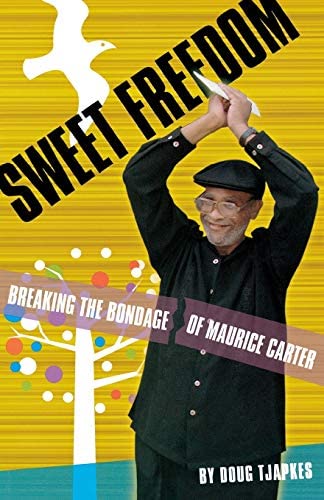On December 20, 1973, off-duty police officer Tom Schadler was shot and injured at the Harbor Wig and Record Shop in Benton Harbor, Michigan. In a hotel room a block away, Maurice Carter, was just waking up. The unassuming and soft-spoken Carter was a high school dropout, down-on-his-luck and scouting the neighborhood in an attempt to relocate from the rough streets of his native Gary, Indiana. Local police picked him up as he exited the hotel and asked him to walk past the Harbor Wig and Record Shop’s front window, where Gwen Jones, an employee who had witnessed the shooting, declared that the light-skinned Carter did not resemble the darker-skinned perpetrator in size, shape or color—and he was released.
But the case remained embarrassingly unsolved, and Carter was arrested in 1975 after a friend perjured himself, fingering Carter as the culprit of the 1973 shooting in an attempt to escape drug charges. In spite of a dearth of physical evidence and flimsy testimony, the all-white jury sentenced Carter to life on a charge of “assault with intent to murder a police officer.” For two decades, he languished in prison—until retired broadcast journalist Doug Tjapkes walked into his life in 1992. In Sweet Freedom: Breaking the Bondage of Maurice Carter, Tjapkes recounts the painstaking fight to clear Carter’s name and bring to justice the true culprit, as well as the unlikely friendship that developed between activist and prisoner as their lengthy battle unfolded. “No arrest was made for two years, which was not a good thing in a racially troubled area where a black man had shot and injured a white cop,” says Tjapkes, who was introduced to Carter through Floyd Caldwell, another wrongfully convicted prisoner. “This case needed closure.”
An undercurrent of racial strife and tension had long been simmering in Benton Harbor. The predominantly black town suffered from high unemployment—a third of the households reported incomes of less than $10,000—and routine police harassment and racial profiling. “We don’t have lynchings here. We have genteel lynchings,” explained Scott Elliott, chair of the biracial Citizens Committee for the Release of Maurice Carter. “We bury them alive in prison.”
Over the next decade, Tjapkes made Carter’s freedom his personal crusade and joined forces with the committee, where he encountered other crusaders, such as Lateesha, a young single mother who, stirred by her Christian faith and neighborhood ties, ignored numerous threats and bribes to secure taped evidence of Carter’s innocence, and political activist Dr. Rubin “Hurricane” Carter, once himself a victim of judicial prejudice, and his organization, Association in Defense of the Wrongly Convicted, which generated international press coverage in support of a new trial. A core of healthcare providers, prisoners, clergy, lawyers, and prison activists also assisted Tjapkes in his mission to obtain sweet freedom for Carter.
In the process, Tjapkes discovered his life’s work. He founded Innocent!, an advocacy organization for wrongfully convicted prisoners, while working on Carter’s case. As a reflection of his faith (he was raised in the Christian Reformed Church) and in order to call on multiple inmates (the Michigan Department of Corrections allows a private citizen to visit only one prisoner per session), Tjapkes became an ordained minister in 2002. “There’s no question in my mind that I am ordained of God to do this work,” he writes. Sweet Freedom is indeed filled with enough inspirational material for a series of Sunday sermons, although Tjapkes, a skilled reporter, is never preachy. Yet students of law and justice reform advocates may be the best poised to negotiate the author’s tale of his dogged journey through the mountains of red tape, local politics, and prejudices entangling the justice system.
Sweet Freedom ends on a bittersweet note. In July 2004, twenty-nine years after Carter entered the Michigan penitentiary system, Gov. Jennifer Granholm commuted his sentence and, at sixty years old, he was free—at last. In October 2004, three short months after his release, he died of advanced liver disease. He had contracted Hepatitis C and a raging staphylococcus infection while in prison. A physician had just completed the paperwork for a liver transplant evaluation before he died.
The bitterest pill, though, is that the man who allegedly pulled the trigger on police officer Schadler still walks free. Many residents in Benton Harbor purportedly heard the man admit to shooting “that white cop” but chose to remain silent out of misplaced loyalty or fear of retaliation. Lateesha’s concealed tape recording includes an admission by the woman who harbored the alleged perpetrator shortly after the shooting. “She states that the black people know who did it, the white people know, and the police know,” writes Tjapkes in his epilogue. “Yet no one did anything about it.” Even if the man were finally arrested and brought to justice, the statute of limitations for the charge of “assault with intent to murder” has expired. Although a few potential witnesses have died and others are getting older with the passage of time, Tjapke vows: “We are not letting this frustrating set of circumstances stop us. We’re continuing knocking on doors. Our goal, as well as that of the police, is to see that justice is finally done.”
- Follow us on Twitter: @inthefray
- Comment on stories or like us on Facebook
- Subscribe to our free email newsletter
- Send us your writing, photography, or artwork
- Republish our Creative Commons-licensed content

